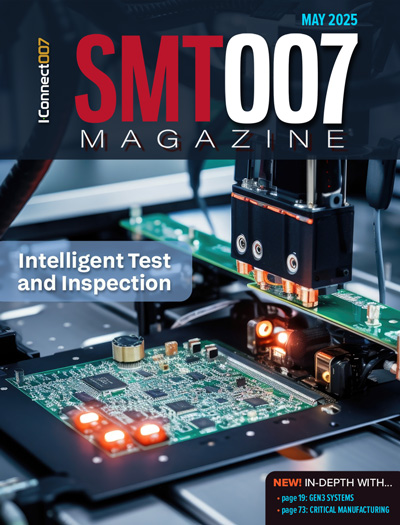-

- News
- Books
Featured Books
- smt007 Magazine
Latest Issues
Current Issue
What's Your Sweet Spot?
Are you in a niche that’s growing or shrinking? Is it time to reassess and refocus? We spotlight companies thriving by redefining or reinforcing their niche. What are their insights?

Moving Forward With Confidence
In this issue, we focus on sales and quoting, workforce training, new IPC leadership in the U.S. and Canada, the effects of tariffs, CFX standards, and much more—all designed to provide perspective as you move through the cloud bank of today's shifting economic market.

Intelligent Test and Inspection
Are you ready to explore the cutting-edge advancements shaping the electronics manufacturing industry? The May 2025 issue of SMT007 Magazine is packed with insights, innovations, and expert perspectives that you won’t want to miss.
- Articles
- Columns
- Links
- Media kit
||| MENU - smt007 Magazine
Why Medtech Manufacturers Should Automate Fluid Dispensing Operations
January 12, 2016 | Kelvin Fernandez, Nordson EFDEstimated reading time: 2 minutes
Researching, designing, developing, and manufacturing medical devices is an exact science. Consequently, fluids used to manufacture medical devices must be dispensed according to scientific principles—especially as devices shrink, parts are closer together, and substrates become more fragile and more prone to contamination. To address these challenges, medtech manufacturers are increasingly turning to the use of robotic dispensing technologies.
Used for bonding, gasketing, filling, lubricating, and sealing, the fluids used in medical device applications range from thick to thin. They can be two-part combinations, viscosity changing, or light curable. In addition, they can be dispensed in single or batch processes or in volume manufacturing operations using fully automated in-line systems. Whether they are used for R&D or prototyping purposes or in low-volume or high-volume production, fluids can be dispensed most precisely, reliably, and repeatedly using automated dispensing systems, enabling manufacturers to save materials, time, labor, and resources.
However, the transition from manual to automated fluid dispensing is more involved than simply deciding to automate. Determining what to automate is key. Thus, manufacturers considering the shift to automated dispensing should look closely at their entire process to ascertain whether automating a part of it will help them to improve safety, performance, product quality, reliability, or productivity.
Contact vs. Non-contact Dispensing
Two methods are commonly employed to dispense process fluids: contact dispensing, in which fluids are dispensed using a dispensing tip, and non-contact dispensing, in which fluids are commonly jetted. A manufacturer should choose one or the other depending on the viscosity and consistency of the fluid and the application requirements.
While contact dispensing produces much smaller deposit sizes than non-contact dispensing, the dispensing tip must be placed close enough to the part so that the fluid can make contact with the tip and part at the same time. In automated dispensing processes, this method is more time-consuming than the non-contact method because the tip must be lowered onto the dispensing area and retracted before it is moved to the next dispensing point.
In contrast, non-contact dispensing accelerates the process because the jetting action does not require automation to lower and raise the tip along the z-axis. Thus, the cycling of the jetting valve—which is usually piezoelectric—is performed at much faster speeds and higher cycle rates than tip dispensing can achieve, allowing for greater cycle time savings.
Editor's Note: This article originally appeared in the January 2016 issue of SMT Magazine.
Testimonial
"In a year when every marketing dollar mattered, I chose to keep I-Connect007 in our 2025 plan. Their commitment to high-quality, insightful content aligns with Koh Young’s values and helps readers navigate a changing industry. "
Brent Fischthal - Koh YoungSuggested Items
Dispense Works RPX Series Robotic Dispensing Machines for Precision Assembly and Custom Automation
07/18/2025 | Dispense Works Inc.Dispense Works Inc., a leader in automated dispensing and precision assembly solutions, offers the RPX Series of robotic dispensing systems.
Techcon Launches New Side-By-Side Dispensing Cartridge Line
06/12/2025 | TechconTechcon, part of OK International and Dover, and a global leader in precision fluid dispensing technologies, today announced the world-wide launch of their new line of Techcon Side-by-Side (SBS) Dispensing Cartridges.
Axxon-Mycronic Showcases Precision Protection Technologies for Extreme Environments at Space Tech Expo
06/02/2025 | Axxon-MycronicAxxon-Mycronic, a leading, global supplier of innovative and production-ready, dispensing and conformal coating systems, is pleased to announce its participation at the Space Tech Expo USA 2025, taking place June 3-4, 2025 at the Long Beach Convention Center in Long Beach, California. Axxon-Mycronic will be exhibiting in Booth #552.
Axxon-Mycronic to Showcase Advanced Coating, Dispensing, and Backend Solutions at IPC APEX EXPO 2025
02/19/2025 | Axxon-MycronicAxxon-Mycronic, a leading, global supplier of innovative and production-ready, dispensing and conformal coating systems, to announce its participation at the IPC APEX EXPO 2025, taking place March 18-20, 2025 at the Anaheim Convention Center.
Rehm Thermal Systems: Future Technologies for Coating, Dispensing and Vapour Phase Soldering Live at IPC APEX EXPO 2025
02/04/2025 | Rehm Thermal SystemsIPC APEX EXPO 2024, which takes place from 18 to 20 March at the Anaheim Convention Center in California, is the largest and most important trade fair for electronics manufacturing in North America.


